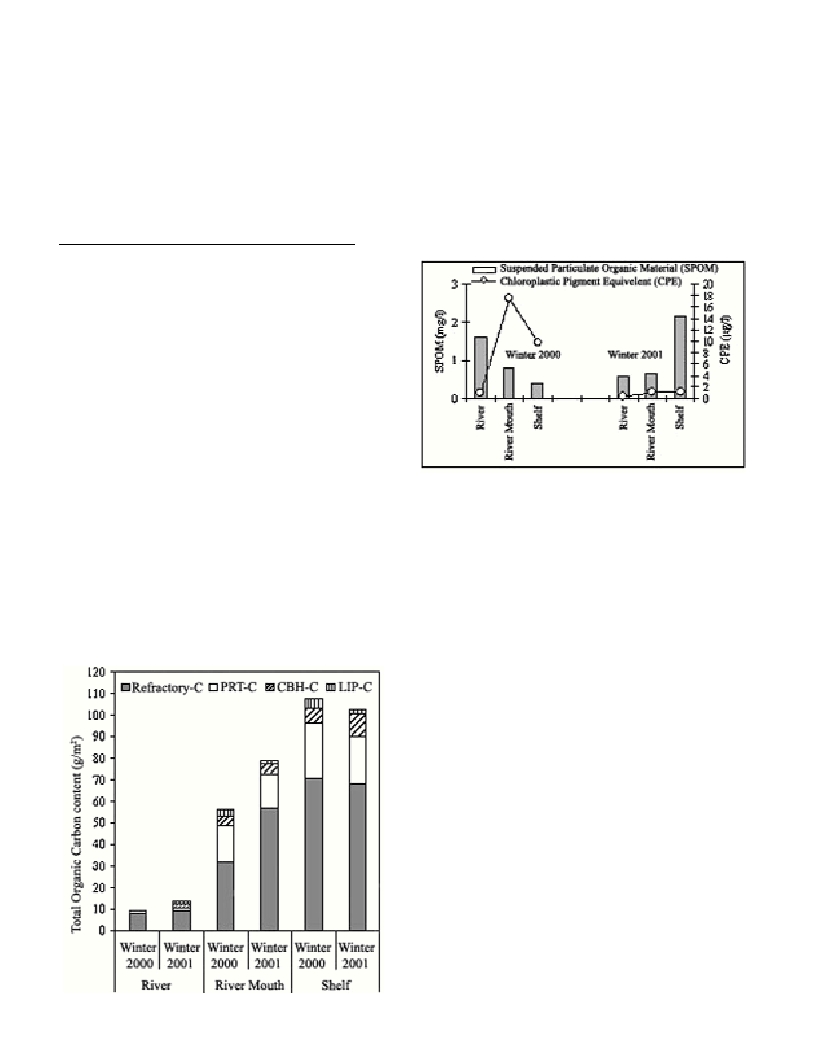SEDIMENTARY ORGANIC MATTER LABILITY ALONG THE RIVER – SHELF TRANSITION ZONE
IN A SEMI-ENCLOSED BAY (MALIAKOS BAY, AEGEAN SEA, GREECE).
Akoumianaki I.
1*
and Nikolaidou A.
2
1
University of Crete, Biology Department, Voutes, Iraklion, Crete, Greece - * akoum@edu.biology.uoc.gr
2
University of Athens, Biology Department, Panepistimiopolis, Athens, Greece - anikol@uoa.gr
Abstract
Sedimentary organic matter lability was estimated along a river-shelf transition zone by measuring the concentrations of biolymeric
compounds (proteins, carbohydrates, lipids) in a semi-enclosed bay in Eastern Mediterranean. Samples were taken in three stations, River,
River Mouth and Shelf, in Winter 2000 and 2001. Biopolymeric concentrations displayed a seaward increase. Contribution of Labile
Carbon to Total Organic Carbon ranged from about 15% (River) to about 35 % (River Mouth, Shelf). These results indicate the presence
of a benthic trophic gradient along the transition zone with a seaward increase in nutritional quality of sedimenaty OM.
Keywords: biopolymers, lability, river-shelf transition zone
Rapp. Comm. int. Mer Médit., 37,2004
165
The sum of proteins (PRT), carbohydrates (CBH) and lipids (LIP),
referred as biopolymers, is used as a measure of the amount of food
potentially available for heterotrophic metabolism [1]. The
contribution of Labile Carbon (LC) to Total Organic Carbon (TOC)
was assessed along a transect in the mixing zone between Sperheios
River and Maliakos Bay (Aegean Sea, Greece) in relation to the
quality of suspended organic material (OM) in the water column.
Samples were taken in three stations, River, River Mouth and Shelf, 1
mile apart, at 2.5, 4 and 22 m depth, respectively, in winter 2000 and
2001. Sediment samples were taken by Ponar grab, water column
samples by Limnos bottles and salinity profiles by Aandera CTD.
Biopolymer and sedimentary chloroplastic pigment concentrations
were measured and converted to carbon equivalents as in [2] and [3]
and to carbon content in the top 6 cm of sediment (g/m
2
) assuming
specific density of 2.6 g/cm
3
.
LC content displays considerable spatial differences along the
mixing zone, with definite seaward increase (Fig. 1), which coincides
with an increase in silt-clay % from River (< 30%) to Shelf (>90%).
Carbohydrate to Protein concentrations ratio, a measure of the relative
contributions of phytodetrital and living material, ranged from 0.88 –
096 in River to less than 0.56 in River Mouth and Shelf stations.
Contribution of sedimentary Chlorophyll aCarbon equivalent to LC
was less than 10% with a peak in River Mouth in both sampling
periods. Suspended Particulate Organic Material (SPOM) and
Chloroplastic Pigment Equivalent (CPE) in water column did not
exhibit consistent spatial trends (Fig. 2), with higher OM inputs in
River in Winter 2000 and low phytodetrital inputs along the transition
zone in Winter 2001. The temporal differences in CPE levels may be
attributed to the fact that sampling in winter 2000 coincided with the
phytoplankton bloom in the area. With respect to salinity, River
station represents a fresh water environment whereas River Mouth
and Shelf are virtually marine.
Fig. 1. Sedimentary Labile Carbon distribution to Total Organic Carbon.
Fig. 2. Suspended Particulate Organic Material and Chloroplastic
Pigment Equivalent along the river-shelf transition zone.
The results of the present study indicate that River sediments are
mainly dominated by refractory material. River station corresponds to
a high energy environment that does not allow the settling and
accumulation of riverine OM while autochthonous primary
production is negligible during winter. In contrast, water mixing in the
estuaries and low hydrodynamic regime in Maliakos Bay favour the
sedimentation of fine suspended material and the accumulation of OM
in the sediments of the River Mouth and the Shelf stations. Although,
primary OM production in water column is relatively high, especially
during the bloom period, the low CBH:PRT ratio provides evidence
that the labile fraction of sedimentary OM along the transect is mainly
composed of living material or freshly derived detritus rather than old
phytodetrital material. Provided that sedimentary chlorophyll a
contributes a small amount to bioplymeric fraction it is assumed that
the high percentage of proteins corresponds to heterotrophic
microbial populations that take advantage of the high OM inputs in
the topsets and the delta front. Concluding, there is a trophic gradient
along the river – shelf transition zone in Maliakos Bay with low
nutritional quality OM in the riverine end and high nutritional quality
OM in the marine end. The consistency of this gradient during winter,
despite temporal variation in the occurrence of phytoplankton bloom
in the area, indicate that benthic processes are not solely coupled to
water column productivity.
References
1-Danovaro R. and Fabiano M., 1995. Seasonal and inter-annual
variation of bacteria in a seagrass bed of the Mediterranean Sea:
relationship with labile organic compounds and other environmental
factors. Aquat. Microb. Ecol.,9:17-26.
2-Puscedu A., Sara G., Armeni M., Fabiano M. and Mazzola A., 1999.
Seasonal and spatial changes in the sediment organic matter
of a semi-enclosed marine system (W-Mediterranean Sea). Hydrobiologia,
397: 56-70.
3-Akoumianaki I., 2003. Effects of riverine inputs to the benthic
communities of a semi-enclosed bay (Maliakos Bay, Aegean Sea). PhD
Dissertation, 300 p. University of Crete, (in Greek).

